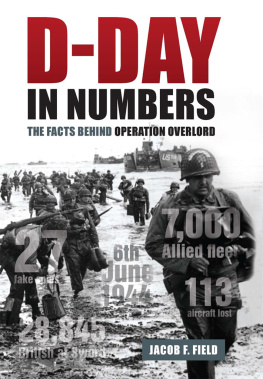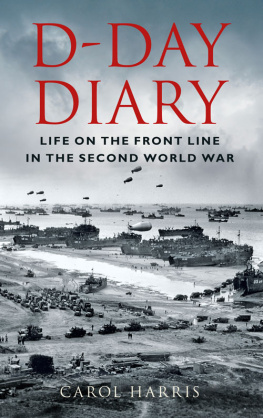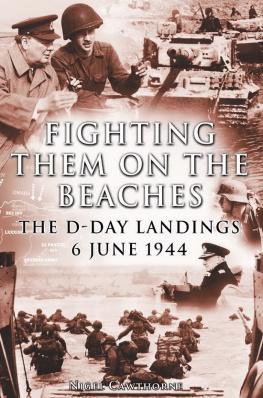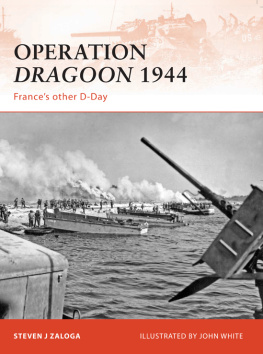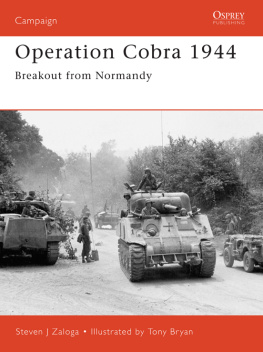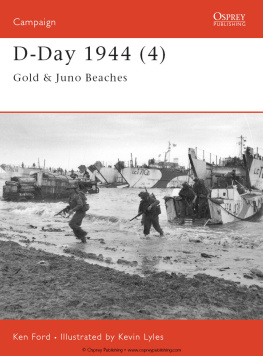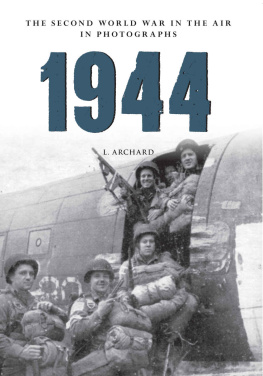
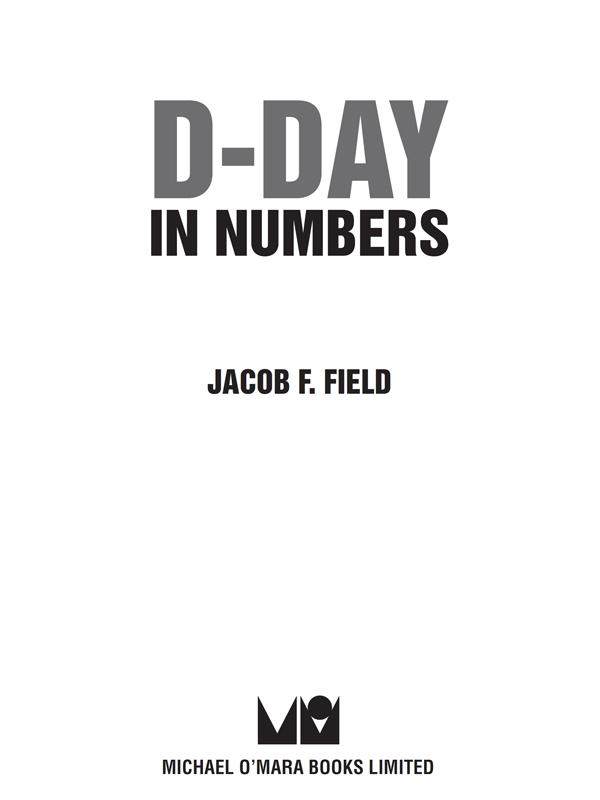
First published in Great Britain in 2014 by
Michael OMara Books Limited
9 Lion Yard
Tremadoc Road
London SW4 7NQ
Copyright Michael OMara Books Limited 2014
All rights reserved. No part of this publication may be reproduced, stored in a retrieval system, or transmitted by any means, without the prior permission in writing of the publisher, nor be otherwise circulated in any form of binding or cover other than that in which it is published and without a similar condition including this condition being imposed on the subsequent purchaser.
A CIP catalogue record for this book is available from the British Library.
ISBN: 978-1-78243-205-0 in hardback print format
ISBN: 978-1-78243-239-5 in ebook format
Designed and typeset by Design 23
Illustrations by David Woodroffe
www.mombooks.com
To Emily
ON 6 JUNE 1944, THE MOST COMPLEX and ambitious invasion in military history took place. The D-Day Landings were the culmination of years of planning and preparation. The invading Allies would disembark at five landing zones code-named Utah, Omaha, Gold, Juno, and Sword. In addition airborne troops would be landed behind enemy lines. They would combine to attempt to drive the Germans out of Normandy. If this effort succeeded then they would pave the way for the liberation of the rest of France and the Low Countries, and eventually a strike into Germany. Failure would delay the end of the war and strain the alliance with the Soviet Union, eager for the western Allies to open up another front against Germany. The invading Allies were facing an enemy that had had years to build up their defences, turning cities into fortresses and scattering the beaches with thousands of obstacles.
Success at Normandy demanded the bravery, skill, and cunning of hundreds of thousands of Allied soldiers, sailors, and airmen. The majority of the servicemen were drawn from the United Kingdom, the United States, and Canada, but many other nationalities played a role. From French Resistance fighters, to Polish tank crews, to Jewish commandos who had fled from persecution in German territory, the Battle for Normandy was a multi-national victory. It was a massive strategic effort, requiring the careful integration of land, maritime, and aerial units. The Allies also had to consider the huge logistical problem of unloading tens of thousands of men, as well as the supplies, equipment, and vehicles they needed to fight. D-Day was also at the centre of one of the great triumphs of the British intelligence service, whose campaign of misinformation was crucial in hiding Allied invasion plans from the Germans.
D-Day in Numbers tells the story of the invasion of Normandy through the statistics and figures associated with the campaign. It begins with the origins of World War II and continues past D-Day to detail the victorious drive through France and into Germany. The numbers are staggering: from the 156,000 Allied troops landed in France on 6 June to the seventeen million cubic metres of concrete the Germans used to construct the network of fortifications protecting the Atlantic coast. Others show the human sacrifice of the conflict; the 10,000 Allied casualties on D-Day, or the 19,890 civilian deaths in the Battle for Normandy. This book details the equipment that helped the Allies win victory, from the ingenious swimming tanks to the Mulberry temporary harbours. Individual units are examined, from the fearsome British Commandos to the notorious Twelfth SS Panzer Division Hitlerjugend. The roles of key figures are examined, like Brigadier General Theodore Roosevelt III, the oldest man ashore on D-Day, Bill Millin, who landed in Normandy playing the bagpipes, and Joan Pujol Garcia, the Catalan double agent who helped the Allies to deceive Germany. D-Day in Numbers reveals the sheer scale of the preparation, execution, and impact of the event that shaped the outcome of World War II.
6,600,000,000
T HE 11 N OVEMBER 1918 armistice ended the fighting in World War I. It took several months for the Allied Powers (led by France, the United States, and the United Kingdom) and Germany to negotiate the Treaty of Versailles, signed on 28 June 1919. Its major point was Article 231, the War Guilt clause, under which Germany accepted responsibility for starting the war. She was liable to pay reparations for the damages the Allies suffered, valued in 1921 at 6,600,000,000, to be paid in a mixture of cash and commodities such as coal. Allied troops were to occupy the Rhineland for fifteen years. This region was in western Germany and an important centre of industry. Germany was to cede territory in Europe, give up its colonies, and was forbidden from joining with Austria. Versailles stripped Germany of its military capacity by limiting its army to 100,000 and its navy to 15,000. Her armed forces were forbidden to use armed aircraft, tanks, or submarines. Many Germans found the treaty offensive, believing that Germany, never fully defeated in the field, had been stabbed in the back by politicians. During the Great Depression of the 1930s high unemployment and hyperinflation struck Germany, leading to a rise in support for radical groups like Adolf Hitlers Nazis. One of Hitlers promises was to tear up Versailles, and restore Germanys greatness. As for the reparations, they were suspended in 1932 due to the Depression, and never resumed. Germany only paid one-eighth of their value. Once in power Hitler sought to reverse Versailles; he built up the size and strength of the German armed forces, in 1936 he remilitarized the Rhineland, and in 1938 Germany annexed Austria.
10,000,000 copies
A DOLF H ITLER S M EIN K AMPF (My Struggle) was a mixture of autobiography, ideology, and political manifesto, steeped in a virulent mixture of anti-Semitism and anti-Communism. Hitler started the work while he was imprisoned after a failed uprising in 1923. It was published in 1925, and sold 23,000 copies in five years. As Hitler rose to power, the books popularity and circulation increased. By 1945 around ten million copies had been sold or distributed. Royalties from Mein Kampf meant Hitler built up a large private fortune.
288 seats
O N 5 M ARCH 1933, the last free elections before the Nazi takeover of Germany were held. Hitler had been chancellor since January, but his National Socialist Workers Party did not have a majority. Despite this, Hitler had been able to repress the Communist Party by arresting its members and launching a propaganda campaign against them. On Election Day Nazi supporters roamed the streets, attempting to sway the vote with the threat of violence. Despite this, the Nazis won only 288 seats with forty-four per cent of the vote. This left them thirty-six seats short of a majority in the Reichstag, meaning they had to form a coalition. This did not stop Hitler from passing the Enabling Act on 23 March, which allowed his cabinet to pass laws without consulting the Reichstag. Trade unions were banned and other political parties were suppressed or forced to disband. On 2 August 1934, the head of state, President Paul von Hindenburg, died. His office was abolished and merged with that of the chancellor. Hitler now became Fhrer und Reichskanzler head of government and head of state. Hitler became Supreme Commander of the German armed forces, who would be made to swear an oath of loyalty to Hitler. In 1935 the Nazi symbol, the swastika, was proclaimed to be Germanys sole national flag. In just a few years Germany had transformed from a multi-party democracy into a militaristic, single-party fascist dictatorship.
Next page
